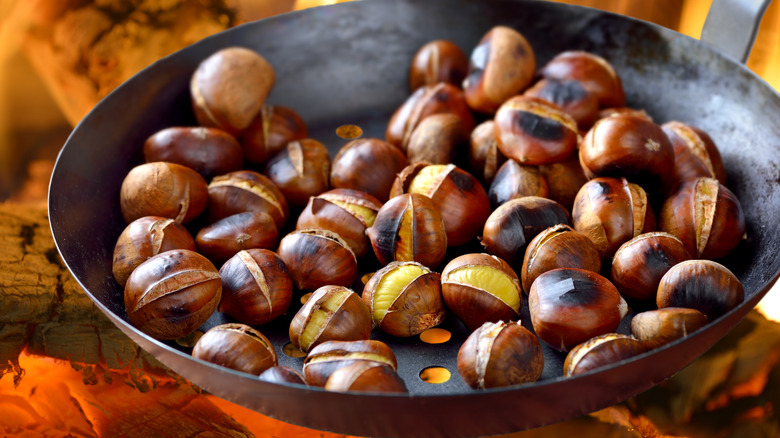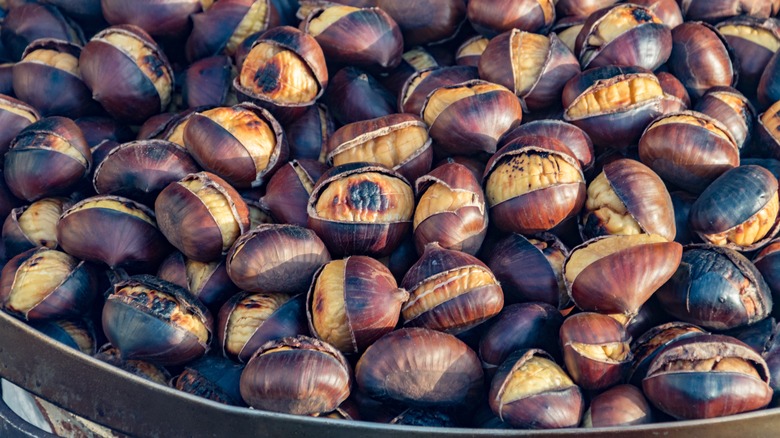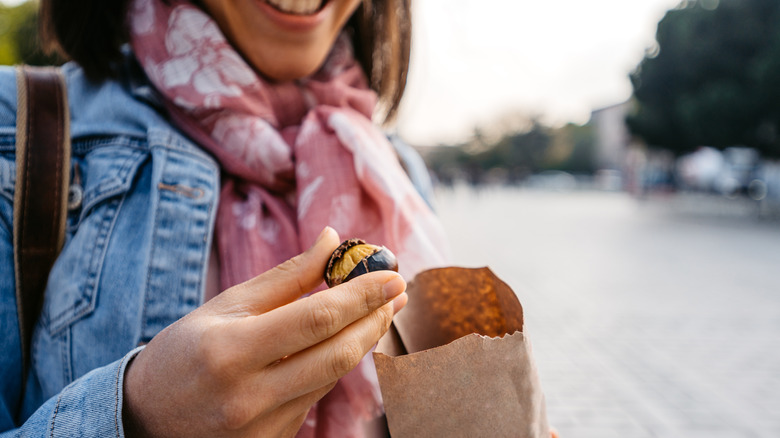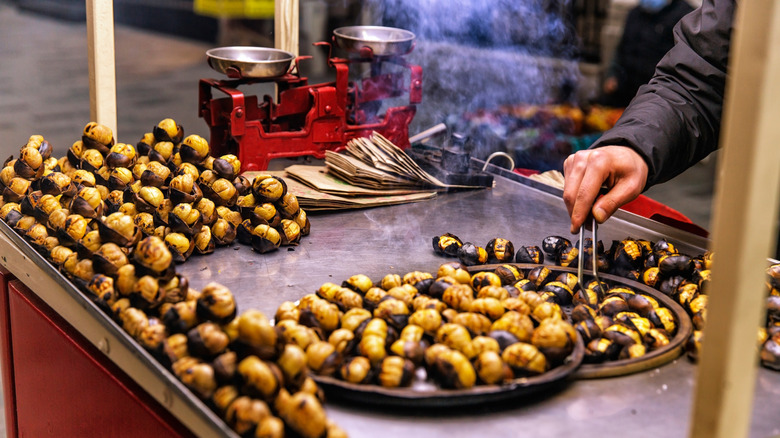The Symbolic Reason Chestnuts Are Eaten On Christmas
When you think about traditional Christmas treats, shortbread cookies and pumpkin pie might come to mind. But, not too long ago, folks were ringing in the holiday with a much less decadent food: roasted chestnuts. If you've never tried one, the mouthful is mealy and the taste is a little, well, lacking. It isn't a spectacularly flavorful treat; most of the flavor is imparted by the roasting process, which adds a cozy sweet-smokiness. But, if "Chestnuts roasting on an open fire" is the first line of an anthem called "The Christmas Song," there has to be a good reason why, right? In fact, December 14 is celebrated as National Roast Chestnuts Day.
Today, chestnuts might not be the first treat you think of around Christmastime, but the tradition is far from dead. Street vendors still sell warm chestnuts on Fifth Avenue before Thanksgiving even rolls around. But, whether or not you try 'em out for yourself, as you knock back a glass of eggnog this season, give the humble chestnut (and its humble history) a second thought. Whether they know it or not, here's why folks eat chestnuts around Christmas.
The season of giving
Chestnuts are historically a subsistence food, having a comparable nutritional value to other dense, starchy foods corn and rice. For a time, roughly 50% of all the trees comprising East Coast forests were American chestnut trees, and they cranked out an estimated 20 million pounds of chestnuts every year. So, the mealy nut was once omnipresent, extremely storable, and affordable.
Much like rice and canned foods today, the poor were given chestnuts on Martinstag aka the Feast of Saint Martin, which falls on November 11. Saint Martin was a transient Catholic saint born during the 4th century in present-day Hungary. He later lived in what is now Italy, where he was drafted into Emperor Constantine II's guard.
The story goes that, while stationed in Rome, Saint Martin cut his jacket in half to share with a beggar who was freezing in the wintertime. This act became known as "Dividing of the Cloak," and is celebrated on Martinstag with songs and bonfires as an act of goodwill. Handing out chestnuts also became a Martinstag activity, as the season that these nutritious nuts become edible coincides with the time St. Martin is celebrated (chestnuts are ready to eat from roughly October to December). This then led to the unlikely emergence but meaningful Christmas tradition of roasting chestnuts on an open fire.
Why don't we roast chestnuts so much anymore?
During the 18th and 19th centuries, America's east coast was covered in nearly four billion chestnut trees, stretching from Maine to Alabama and west to Kentucky and Ohio. These chestnut trees weren't just plentiful either, they were gargantuan. Over 100 feet tall and 10 feet wide was average. But, all that changed when a lethal fungus called the chestnut blight hit. In 1904, a gardener at the New York Zoological Park first noticed one tree exhibiting signs of an illness. It was traced back to an Asian chestnut tree that was imported to Long Island, and in 40 years, 3.5 billion of the country's 4 billion trees had died.
That's why the American Chestnut Foundation was founded in 1983. Plant scientists have been trying to create a strain of chestnut trees resistant to the American chestnut disease, and test plots are already growing in Pennsylvania, Virginia, North Carolina, and Tennessee. Today, America still imports around $20 million worth of chestnuts every single year from China, Korea, and Italy to keep the centuries-old tradition alive. And, roasting chestnuts remains a popular part of the holiday season for many Italian families.
Enjoy a taste of Christmases past
Chestnuts are technically part nut, part vegetable. They're great for roasting because, unlike other nuts, the chestnut meat is 50% to 60% water, making it soft and chewy rather than hard — and perishable. They must be refrigerated within a few weeks after harvesting or they will dry out and go bad. Due to their high water content, they're even susceptible to molding.
Raw chestnuts taste vegetal and sweet like a carrot. But, a bag of charred chestnuts from the grocery store isn't exactly delicious. They're mealy and kind of tough to swallow. Roasting brings out their candied, sweeter, deeper, nuttier quality. If you want to roast them at home and channel the Christmases of yore, you can find raw chestnuts at many grocery stores during the holiday season or at local farmers' markets. Look for firm, glossy nuts for maximum freshness. You don't need an open fire, either. You can roast those chestnuts right in your oven or boil 'em on the stovetop. You can even use a microwave to get the job done.
But, straight-up is far from the only way to enjoy roasted chestnuts. You can incorporate them into soups, stuffing, and gravy. And, classic French Marrons Glacé are chestnuts candied with vanilla.



